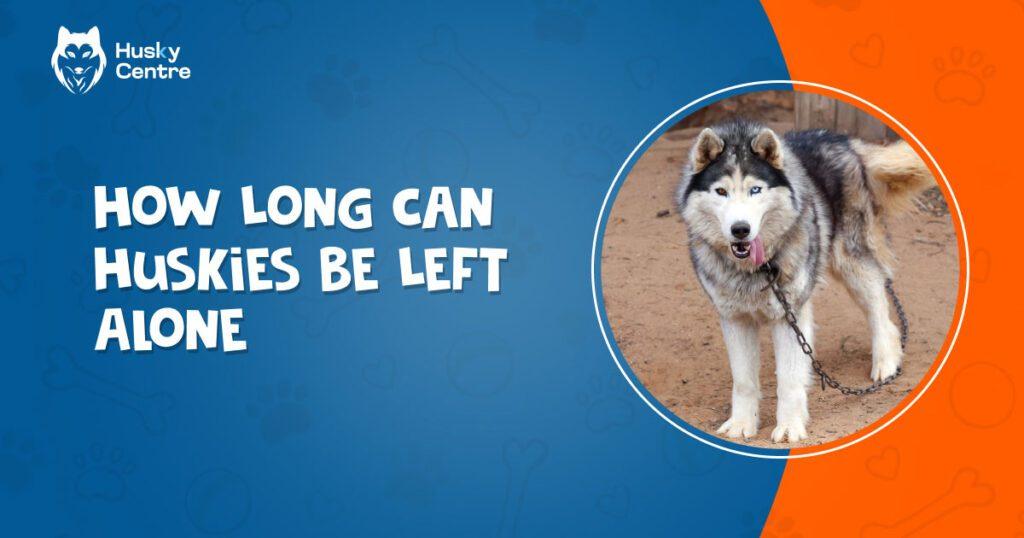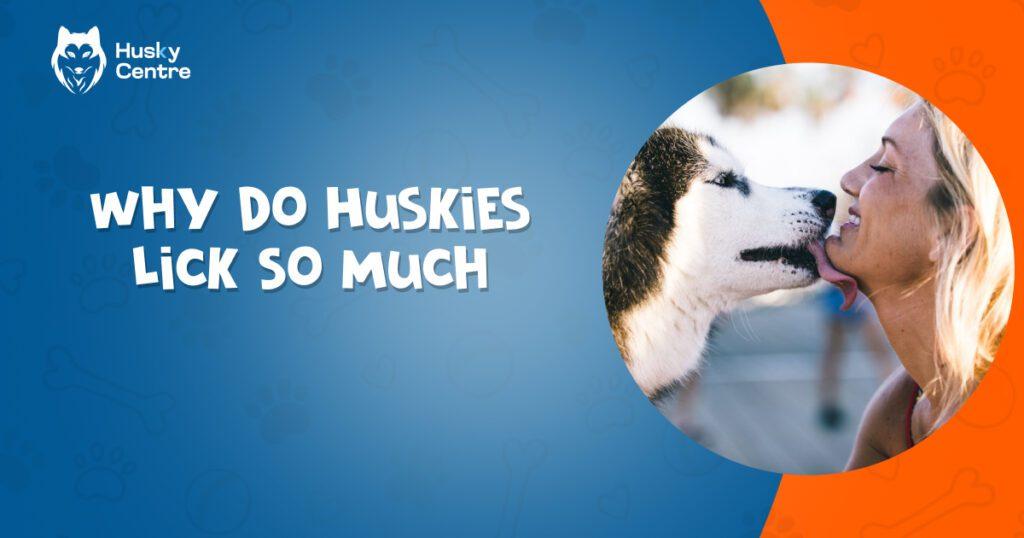Huskies should not be left alone for more than 4-6 hours. Extended isolation can lead to anxiety and destructive behavior.
Huskies are known for their intelligence, energy, and social nature. These traits make them wonderful companions but also require attentive care. Leaving a Husky alone for too long can result in boredom and stress. This breed thrives on interaction, physical activity, and mental stimulation.
Owners must ensure that their Huskies receive ample exercise and engagement daily. Providing toys, puzzles, and interactive sessions can help keep them occupied. Proper planning and understanding of a Husky’s needs are essential for their well-being. If you must leave your Husky alone, consider hiring a pet sitter or arranging for doggy daycare to ensure they remain happy and healthy.
Understanding The Huskies Temperament
Huskies are known for their striking appearance and energetic nature. Many potential owners wonder, “How long can Huskies be left alone?” To answer this, understanding the Huskies’ temperament is crucial. Huskies have unique traits that influence their behavior when left alone, impacting their well-being and happiness.
Understanding The Huskies’ Temperament
Huskies are intelligent, independent, and strong-willed. They are known for their playful and friendly demeanor. Their temperament plays a significant role in determining how they cope with being alone.
Huskies’ Social Nature
Huskies are inherently social animals. They enjoy the company of other dogs and humans. Leaving them alone for extended periods can lead to loneliness and anxiety.
High Energy Levels
Huskies have high energy levels and need regular exercise. A lack of physical activity can make them restless and destructive. Owners must ensure their Huskies get enough exercise daily.
Independent Yet Attached
While Huskies are independent, they form strong bonds with their families. They may feel abandoned if left alone for too long. It’s important to balance their need for independence with their need for companionship.
Prone To Boredom
Huskies are smart and can get bored quickly. Boredom can lead to unwanted behaviors such as chewing and digging. Providing mental stimulation is essential to keep them engaged.
Separation Anxiety
Huskies can develop separation anxiety if left alone frequently. Signs of anxiety include excessive barking, howling, and destructive behavior. Gradual training can help alleviate this anxiety.
| Temperament Trait | Impact on Being Left Alone |
| Social Nature | May feel lonely and anxious when left alone |
| High Energy | Needs regular exercise to prevent restlessness |
| Independent | Can feel abandoned if left alone too long |
| Prone to Boredom | Needs mental stimulation to avoid destructive behaviors |
| Separation Anxiety | May develop anxiety with frequent alone time |
The Ideal Time Alone
Huskies are known for their energetic and playful nature, which makes them wonderful companions. But how long can Huskies be left alone? Understanding the ideal time alone for your Husky is crucial for their well-being and happiness. Let’s delve into the recommended duration they can be left alone and the factors influencing this time.
Recommended Duration Huskies Can Be Left Alone
The ideal time a Husky can be left alone varies based on their age and training. Puppies should not be left alone for more than 2-3 hours. They need frequent bathroom breaks and social interaction to prevent separation anxiety.
For adult Huskies, the recommended duration is around 4-6 hours. Adult Huskies are more independent and can handle longer periods alone, but they still need mental and physical stimulation. Here are some key points to consider:
- Age: Younger Huskies need more attention and care.
- Training: Well-trained Huskies can handle being alone better.
- Exercise: Ensure they get enough exercise before leaving them alone.
A well-exercised Husky is less likely to engage in destructive behavior. Providing them with toys and puzzles can keep them occupied and happy. Here’s a quick table summarizing the recommended duration:
| Age | Recommended Duration |
| Puppies | 2-3 hours |
| Adult Huskies | 4-6 hours |
Factors Influencing Time Alone
Several factors influence how long a Husky can be left alone. Understanding these factors can help in making the right decisions for your pet’s care:
- Age: Younger Huskies need more supervision and potty breaks. Older Huskies might need more frequent health checks.
- Training: Huskies that are well-trained can stay alone for longer periods without issues.
- Exercise Needs: Huskies are high-energy dogs. A tired Husky is a happy Husky. Ensure they get enough playtime and walks.
- Health Conditions: Health issues can affect how long they can stay alone. Always consider their health before leaving them alone.
- Separation Anxiety: Some Huskies suffer from separation anxiety. In such cases, they should not be left alone for extended periods. Consider using calming products or hiring a pet sitter.
Providing a comfortable and secure environment with plenty of toys can help in keeping them calm. Interactive toys, treat-dispensing puzzles, and chew toys can engage them and reduce stress.
Potential Risks Of Leaving Huskies Alone For Too Long
Huskies are known for their energy and intelligence, which makes them wonderful pets. However, leaving them alone in an apartment or home for too long can lead to several potential risks. Understanding these risks can help you ensure your Husky remains happy and healthy.
Separation Anxiety
Huskies are social animals and can suffer from separation anxiety when left alone. Separation anxiety can cause a range of issues:
- Excessive barking or howling: Huskies may bark or howl loudly when they are anxious.
- Destructive behaviors: They might chew on furniture or dig up the yard.
- Accidents inside the house: An anxious Husky may urinate or defecate indoors.
These behaviors are signs that your Husky is feeling stressed and lonely. It’s important to address these issues promptly to ensure your pet’s well-being.
Destructive Behavior
Huskies left alone for long periods can engage in destructive behavior in aggression. This is often a result of their high energy levels and need for mental stimulation.
Common destructive behaviors include:
- Chewing: Huskies may chew on furniture, shoes, or other household items.
- Digging: They might dig holes in the yard or garden.
- Escaping: Huskies are known to escape from yards or houses if they feel bored.
Providing toys and engaging activities can help reduce these behaviors. Regular exercise is also crucial for keeping your Husky occupied and happy.
Boredom And Mental Health
Leaving a Husky alone for too long can lead to boredom and mental health issues. A bored Husky can become depressed or anxious, which can impact their overall well-being.
Signs of boredom in Huskies include:
- Lethargy: A bored Husky may seem less energetic and more withdrawn.
- Excessive sleeping: They might sleep more than usual due to a lack of stimulation.
- Repetitive behaviors: Pacing or excessive licking can indicate boredom.
To prevent boredom, it’s essential to provide mental stimulation and regular exercise. Interactive toys, puzzle feeders, and training sessions can keep your Husky mentally engaged and happy.
Preparing Your Husky For Alone Time
Huskies are known for their energetic and sociable nature. They thrive on interaction and activity, making it a challenge to leave them alone for extended periods. Preparing your Husky for alone time is crucial to ensure they remain happy and well-behaved. By training them gradually and creating a safe environment, you can help your Husky adjust to being alone without experiencing stress or anxiety.
Gradual Training And Acclimation
To prepare your Husky for alone time, start with gradual training and acclimation. This process helps them become comfortable with your absence in small, manageable steps.
Here are some steps to follow:
- Start with short periods: Leave your Husky alone for just a few minutes at first. Gradually increase the time as they get used to it.
- Use positive reinforcement: Reward your Husky with treats and praise when they remain calm while you’re away.
- Practice leaving and returning: Repeat this process several times a day. This helps your Husky understand that you will always come back.
- Introduce a routine: Consistency is key. Establish a routine where your Husky knows when to expect alone time.
Consistency and patience are vital during this training. Expect gradual progress and stay calm to avoid transferring any anxiety to your dog.
Creating A Safe And Comfortable Environment
A safe and comfortable environment is essential for your Husky’s well-being while they are alone. Ensure their space is secure and equipped with everything they need.
Consider the following:
| Requirement | Details |
| Secure area | Use a crate or a designated room where your Husky feels safe. |
| Comfortable bedding | Provide a cozy bed or blanket for relaxation. |
| Toys and activities | Include chew toys, puzzle feeders, and other interactive toys to keep them occupied. |
| Food and water | Ensure fresh water is always available and consider a timed feeder if you’ll be gone for long. |
Additionally, ensure the room is free from hazards like electrical cords and small objects. Consider leaving a piece of your clothing with your scent to comfort your Husky. A safe and comfortable environment helps reduce anxiety and keeps your Husky entertained and relaxed during alone time.
Tips For Managing Alone Time
Huskies are known for their high energy levels and need for companionship. Leaving them alone for too long can lead to behavioral issues. Proper management of their alone time is crucial. Here are some effective tips for ensuring your Husky stays happy and healthy when left alone.
Physical Exercise And Mental Stimulation
Huskies need ample physical exercise and mental stimulation to stay content. Regular activity helps them release energy and reduces anxiety.
- Morning Walks: Start the day with a brisk 30-minute walk. This helps burn off excess energy.
- Interactive Toys: Use puzzle toys that challenge their minds. This keeps them entertained.
- Playtime: Spend time playing fetch or tug-of-war. It strengthens your bond and tires them out.
Incorporate variety in their exercise routine. Change the walking routes and introduce new toys. This keeps them engaged and prevents boredom.
| Activity | Duration | Frequency |
| Morning Walk | 30 minutes | Daily |
| Interactive Toys | 15-20 minutes | Twice a day |
| Playtime | 20-30 minutes | Daily |
Hiring A Pet Sitter Or Dog Walker
Consider hiring a pet sitter or dog walker. This ensures your Husky gets attention and exercise during the day.
- Regular Walks: A dog walker can take your Husky out for walks. This keeps them active and happy.
- Companionship: A pet sitter provides company. This reduces feelings of loneliness.
- Peace of Mind: Knowing someone is caring for your pet gives you peace of mind.
What to Look for in a Pet Sitter or Dog Walker:
- Experience: Ensure they have experience with high-energy breeds like Huskies.
- References: Check references to ensure they are reliable.
- Availability: Confirm their availability matches your schedule.
Hiring a professional can significantly improve your Husky’s quality of life when you’re not around.
Using Doggy Daycare
Doggy daycare is a great option for Huskies. It provides a safe environment where they can play and socialize.
- Socialization: Your Husky will interact with other dogs. This improves their social skills.
- Supervised Play: Trained staff supervise playtime, ensuring safety and fun.
- Daily Exercise: Daycare offers structured activities. This keeps your Husky active.
- Visit the Facility: Check the cleanliness and safety measures in place.
- Meet the Staff: Ensure they are trained and experienced with Huskies.
- Trial Day: Schedule a trial day to see how your Husky adapts.
Doggy daycare can be a fantastic solution, providing your Husky with an enriching environment during your absence.
Technology And Tools To Help
Huskies are energetic and social dogs. Leaving them alone for long periods can be challenging. Technology and tools can help keep your Husky happy and healthy. These tools can reduce stress and anxiety in your pet.
Pet Cameras And Monitoring Systems
Pet cameras and monitoring systems are essential for keeping an eye on your Husky. These devices allow you to watch your pet and interact with them remotely. This can be very helpful if you are at work or running errands.
Some popular features of pet cameras include:
- Two-way audio: Talk to your Husky and hear their responses.
- Live video streaming: See what your pet is doing in real-time.
- Motion detection alerts: Get notified if your Husky is active or distressed.
- Treat tossing: Reward your pet with treats from a distance.
Here is a table comparing some popular pet cameras:
| Camera | Price | Features |
| Furbo | $199 | Two-way audio, treat tossing, night vision |
| Petcube | $179 | Two-way audio, laser toy, 1080p video |
| Wyze Cam | $25 | Two-way audio, night vision, motion alerts |
Automated Feeders And Water Dispensers
Automated feeders and water dispensers ensure your Husky has access to food and water at all times. These devices can be programmed to dispense food and water at specific times, making it easier to maintain your pet’s diet and hydration.
Benefits of using automated feeders and water dispensers include:
- Consistent feeding schedule: Helps keep your Husky’s eating habits regular.
- Portion control: Prevents overeating and helps manage weight.
- Fresh water supply: Ensures your pet always has clean water.
- Convenience: Reduces the need for you to be present during feeding times.
Here is a comparison of some top automated feeders and water dispensers:
| Device | Price | Features |
| PetSafe Smart Feed | $129 | Wi-Fi enabled, portion control, app control |
| WOPET Automatic Feeder | $89 | Voice recording, portion control, dual power supply |
| PetSafe Drinkwell | $45 | Free-falling stream, replaceable filters, adjustable flow |
Interactive Toys And Treat Dispensers
Interactive toys and treat dispensers keep your Husky entertained and mentally stimulated. These toys can prevent boredom and destructive behavior while you are away.
Some popular types of interactive toys and treat dispensers include:
- Puzzle toys: Challenge your Husky to solve puzzles for treats.
- Automatic ball launchers: Keep your pet active by playing fetch automatically.
- Treat-dispensing toys: Reward your Husky with treats as they play.
- Chew toys: Provide a safe outlet for your pet’s chewing instincts.
Here is a table of some recommended interactive toys and treat dispensers:
| Toy | Price | Features |
| KONG Classic | $13 | Durable, treat-dispensing, chew-resistant |
| Nina Ottosson Puzzle | $20 | Interactive, mentally stimulating, treat-rewarding |
| iFetch Automatic Ball Launcher | $115 | Automatic, adjustable distance, fun |
Special Considerations For Puppies
Huskies are known for their boundless energy and friendly nature. While adult Huskies can manage being alone for a few hours, Husky puppies require special attention. Puppies have specific needs that must be addressed to ensure their well-being and happiness.
Specific Needs Of Husky Puppies
Husky puppies need constant supervision. They are curious and can easily get into trouble. Here are some specific needs:
- Frequent Feeding: Husky puppies need to eat more often than adult dogs. They usually require 3-4 small meals a day.
- Regular Potty Breaks: Puppies have small bladders and need to relieve themselves every 2-3 hours.
- Socialization: Early socialization is crucial. They need to interact with people and other animals to develop good behavior.
- Exercise: Puppies have a lot of energy. Short play sessions throughout the day are necessary to keep them happy and healthy.
- Training: Basic training should start early. Commands like sit, stay, and come are important for their safety.
Leaving a Husky puppy alone for extended periods can lead to separation anxiety. They might chew on furniture, bark excessively, or become destructive. To prevent this, ensure they have toys to keep them occupied and consider hiring a pet sitter or enrolling them in puppy daycare.
Puppy-proofing Your Home
Puppy-proofing your home is essential to keep your Husky puppy safe. Here are some tips to help you puppy-proof your home:
- Secure Loose Wires: Puppies love to chew. Make sure to hide or secure any loose electrical wires.
- Remove Toxic Plants: Some plants are harmful to dogs. Ensure none of these are within reach of your puppy.
- Store Chemicals Safely: Household cleaners and chemicals should be kept in locked cabinets.
- Use Baby Gates: Block off areas of the house where you don’t want your puppy to go.
- Keep Small Objects Out of Reach: Puppies might swallow small items. Ensure they are kept out of reach.
Creating a safe space for your Husky puppy is crucial. Consider setting up a playpen or a puppy-proofed room where they can stay when you are not around. This area should have their bed, toys, food, and water.
A table to summarize the puppy-proofing steps:
| Task | Reason |
| Secure Loose Wires | Prevent chewing and electrical hazards |
| Remove Toxic Plants | Prevent poisoning |
| Store Chemicals Safely | Avoid accidental ingestion |
| Use Baby Gates | Restrict access to dangerous areas |
| Keep Small Objects Out of Reach | Prevent choking hazards |
Taking these steps ensures that your Husky puppy stays safe and healthy while you are away.
Signs Your Husky Is Struggling With Alone Time
Huskies are known for their spirited nature and strong pack instincts. Leaving them alone for extended periods can be challenging. It’s crucial to recognize the signs your Husky is struggling with alone time. This helps you take appropriate steps to ensure their well-being and happiness.
Behavioral Indicators
Huskies often exhibit specific behavioral indicators when they are unhappy with being left alone. These signs can help you identify if your Husky is facing difficulties.
- Excessive Barking or Howling: A Husky left alone might bark or howl continuously. This is a clear sign of distress.
- Destructive Behavior: Chewing furniture, digging, or scratching doors are ways your Husky shows frustration.
- House Soiling: Even a house-trained Husky might have accidents indoors if they feel anxious.
- Escaping Attempts: Your Husky might try to escape from the house or yard. This is a strong indicator of their need for companionship.
- Depression or Lethargy: A Husky that appears unusually quiet or sad may be feeling lonely.
| Behavior | Possible Cause |
| Excessive Barking | Loneliness or Anxiety |
| Destructive Behavior | Frustration or Boredom |
| House Soiling | Stress or Anxiety |
| Escaping | Desire for Companionship |
| Depression | Isolation |
Steps To Take If Your Husky Is Struggling
If your Husky shows signs of struggling with alone time, it’s important to take action. Here are some steps to help your Husky cope better.
- Provide Enrichment: Offer toys, puzzles, and chews. This keeps your Husky mentally stimulated.
- Hire a Dog Walker: A mid-day walk can break up the long hours alone.
- Use Doggy Daycare: This provides social interaction and exercise during the day.
- Training: Train your Husky to be comfortable with alone time gradually. Start with short periods and increase them slowly.
- Companionship: Consider getting another pet to keep your Husky company.
- Create a Safe Space: Designate a comfortable area with their bed and favorite toys.
Taking these steps can greatly improve your Husky’s ability to handle being alone. Each action can make a significant difference in their overall happiness and well-being.
Frequently Asked Questions
Can Huskies Be Alone For 8 Hours?
Huskies can be left alone for 8 hours, but it’s not ideal. They need exercise, mental stimulation, and companionship.
What Do I Do With My Husky While At Work?
Provide toys and puzzles to keep your husky engaged. Hire a dog walker or use doggy daycare services. Ensure they have a comfortable space.
Can A Husky Live Alone?
Huskies are social dogs and prefer companionship. Leaving them alone for long periods can lead to anxiety and destructive behavior.
How Long Can A Husky Stay In A Crate?
A husky can stay in a crate for up to 4-6 hours during the day. Ensure plenty of exercise and bathroom breaks.
Conclusion
Leaving huskies alone for long periods can lead to behavioral issues. Ensure they get enough exercise and mental stimulation. Consider pet sitters or doggy daycare if you’re away often. Understanding your husky’s needs ensures a happy, well-adjusted pet. Prioritize their well-being to enjoy a loving, loyal companion.


Meet Jarred, the heart and soul behind HukyCentre. With a deep affection for furry friends, he pours his passion into every word he writes. His genuine love for dogs shines through in his engaging and informative content. As a dedicated dog enthusiast, Jarred’s goal is to share valuable insights and tips that resonate with fellow dog lovers. Join Jarred on the journey as he celebrates the joy and companionship that dogs bring into our lives.



